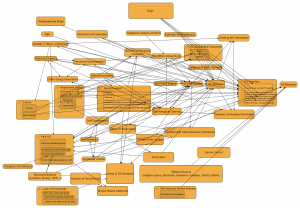Thousands of studies have been conducted on the factors that influence who will or who won’t seek help for a mental health problem. These studies have looked at hundreds of different help-seeking constructs such as “help seeking attitudes” and “self-stigma of seeking help” that are thought to be the precursors/determinants/causes/predictors of actual help seeking behavior.
However, most people are not aware of all of these different help-seeking factors that have been empirically studied by scientists. Therefore, we wanted to create a sample “Mind Map” of just a small portion of these help-seeking factors. A mind map is a diagram used to visually organize information in two dimensional space. By looking at this mind map, we hope to raise awareness of some of the different help-seeking factors that may be worth investigating and targeting with clinical and prevention interventions. The Mind Map has the names of the factors, arrows connecting factors that have been shown to correlate with each other, and the factors are arrayed (roughly) in causal order from left to right.
For more help-seeking resources, including theory, constructs, and measures, please visit HelpSeekingResearch.com, which includes a curated list of systematic reviews and meta-analyses focused on mental health help seeking, which can give you a much more comprehensive picture of the constructs that have been examined beyond the small portion highlighted in this mind map.
You can download and view the latest version of the Help-Seeking Factors Mind Map (Version 1.1, Revised 7-21-2018) in several ways.
- You can dynamically explore the Help-Seeking Factors Mind Map using the VUE Mind Map Software (download the free VUE Mind Map software created by Tufts University) that was originally used to create and edit the Mind Map.
- You can download a zoomable PDF of the Help-Seeking Factors Mind Map
- You can view a zoomable picture of the Help-Seeking Factors Mind Map in your web browser by clicking on the picture below

To learn which published studies examined which sets of factors in this Mind Map, check out the Help-Seeking Factors Mind Map Citations Table, which you can also download as an Excel file. This table contains information about what factor relationships have been studied, what measures were used to measure those factors, the APA-style citation for the studies used to build the Mind Map, and (for certain studies) the effect size of the relationship between two given factors.
This resource was created on behalf of the HAMMER Lab by Chase Herndon.
Lastly, here is an additional list of variables/constructs/factors that have been measured and/or discussed in the help seeking and treatment access literature: the Help Seeking & Treatment Access Variables, Factors, Constructs List. It’s not exhaustive nor has it been updated in many years, but it is a great way to get a sense for the huge variety of things that have been discussed in relation to help seeking.